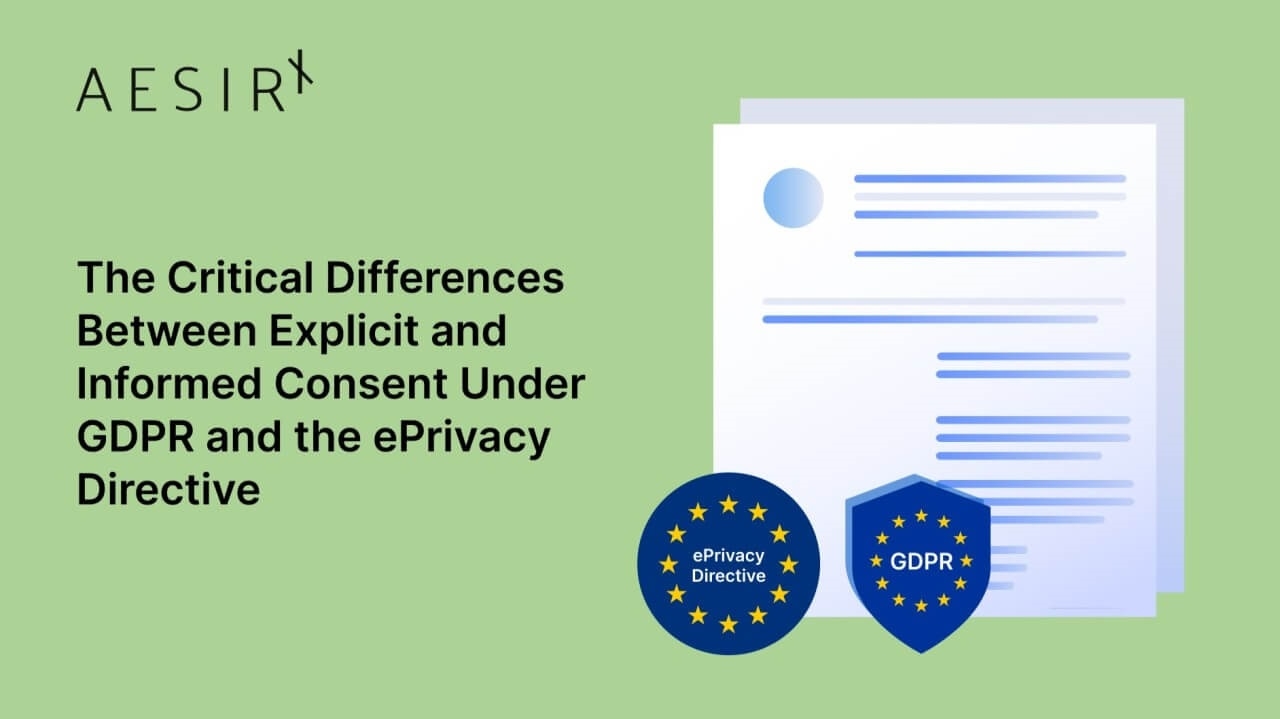In the ongoing conversation about digital privacy, the terms "explicit consent" and "informed consent" often come up, but they’re not always clearly understood. As businesses manage the complex requirements of GDPR and the ePrivacy Directive, understanding these concepts is crucial. Misunderstandings can lead to compliance failures, especially when implementing consent mechanisms for cookies, beacons, and pixel trackers. This article will clarify the differences between explicit and informed consent and explain why both are essential in ensuring compliance and building user trust.
What is Explicit Consent?
Under the GDPR, explicit consent is a stringent form of consent required in situations where the processing of personal data involves higher risks, such as when handling sensitive data or making decisions based on automated processing (e.g., profiling). Explicit consent is characterized by the need for clear affirmative action from the user. This means users must actively indicate their agreement, such as by clicking an "I Agree" button or filling out a consent form. Importantly, this consent must be unambiguous and freely given, leaving no room for assumptions or implied consent.
What is Informed Consent?
Informed consent, a core principle of GDPR and the ePrivacy Directive, requires that users are fully aware of what they are consenting to before any data processing begins. This includes understanding what data is being collected, how it will be used, who it will be shared with, and the rights they have regarding their data. For consent to be truly informed, the information provided to users must be clear, concise, and accessible, enabling them to make a knowledgeable decision about their privacy.
Why Both Explicit and Informed Consent Matter
The distinction between explicit and informed consent becomes particularly significant when considering the requirements of the ePrivacy Directive, especially Article 5(3), which governs the use of cookies and other tracking technologies. While GDPR focuses on personal data processing, the ePrivacy Directive extends these principles to any data access or storage on a user’s device, regardless of whether personal data is involved.
Clarifying the Relationship Between GDPR and ePrivacy Directive Consent Requirements
While GDPR and the ePrivacy Directive (ePD) govern different aspects of data protection, their consent requirements are closely related, particularly when it comes to the stringent standards they both impose.
GDPR's Explicit Consent vs. ePD Article 5(3) Consent
GDPR’s Explicit Consent: Under GDPR, explicit consent is required for specific data processing activities, particularly those involving sensitive data or automated decision-making processes. This consent must be a clear, affirmative action—users must actively opt in, ensuring that there is no ambiguity about their consent.
ePD Article 5(3) Consent: Although the ePrivacy Directive uses slightly different language, the consent requirement under Article 5(3) is effectively as rigorous as GDPR’s explicit consent. The ePD mandates that consent must be obtained before any data is stored or accessed on a user’s device, which includes cookies, beacons, and pixel trackers. This consent must also be informed and unambiguous, ensuring users understand what they are consenting to before any action is taken.
Why the Similarity Matters: Understanding the similarity between these two requirements is crucial because it means that businesses must approach consent under both GDPR and ePD with the same level of seriousness. The European Data Protection Board (EDPB) has emphasized that consent under the ePD must meet the same standards of clarity, specificity, and user control as consent under GDPR. This means that any mechanism used to gather consent—whether for data processing or device access—must ensure that the user’s agreement is both informed and explicit.
Recognizing that the consent requirements under GDPR and ePD Article 5(3) are effectively aligned helps businesses streamline their compliance efforts. By ensuring that all consent gathered is both informed and explicit, businesses can meet the high standards set by both regulations, thereby protecting themselves from legal risks and building stronger relationships with their users.
Common Pitfalls in Implementing Consent
Many businesses, particularly those using third-party consent management platforms, fall into the trap of failing to secure proper consent before data collection begins. For instance, it’s common for cookies, beacons, or pixel trackers to load on a webpage before the user has had the chance to provide consent. This practice not only risks non-compliance with the ePrivacy Directive but also undermines user trust.
The European Data Protection Board (EDPB) has clarified that consent must be obtained prior to any data collection. Pre-ticked boxes, implied consent, or consent obtained after data collection begins are not compliant. This is where many third-party solutions falter, as they often prioritize functionality over compliance, leading to the premature loading of tracking scripts.
For businesses, this means that the consent mechanisms implemented to comply with GDPR should also satisfy the requirements of the ePrivacy Directive. However, many third-party solutions currently fall short, particularly when they allow data collection to begin before consent is fully obtained. This is where adopting robust first-party solutions, which prioritize compliance with both sets of regulations, can provide a significant advantage.
Best Practices for Achieving Compliance
To ensure both explicit and informed consent are properly obtained, businesses should consider the following best practices:
Implement Clear and Transparent Consent Mechanisms:
- Ensure that your consent requests are clear and specific. Avoid using pre-ticked boxes or ambiguous language that could confuse users.
- Provide detailed information about the types of data being collected, their purpose, and how they will be used.
Delay Data Collection Until After Consent:
- Modify your website’s code to defer the loading of any tracking technologies until after the user has provided consent. This includes cookies, beacons, and pixel trackers.
- Utilize consent management platforms that prioritize compliance, such as AesirX’s first-party solutions, which ensure that no data is collected before consent is explicitly and informedly given.
Regularly Review and Update Your Consent Practices:
- As regulations and best practices evolve, so should your consent mechanisms. Regularly audit your consent processes to ensure ongoing compliance.
- Stay informed about updates from regulatory bodies like the EDPB to adapt your practices accordingly.
Understanding and correctly implementing both explicit and informed consent are critical for compliance with GDPR and the ePrivacy Directive. As digital privacy continues to be a focal point of regulatory scrutiny, businesses that get consent right will not only avoid potential fines but also build stronger, trust-based relationships with their users. By ensuring that consent is both informed and explicit, you demonstrate a commitment to privacy that can set your business apart in today’s competitive digital arena.
Are you confident that your current consent practices meet the stringent requirements of GDPR and the ePrivacy Directive? If not, it might be time to reassess and refine your approach. Start by using tools like the AesirX Privacy Scanner to evaluate your current practices and explore first-party solutions that prioritize compliance and user trust.
Ronni K. Gothard Christiansen // VikingTechGuy
Creator, AesirX.io




